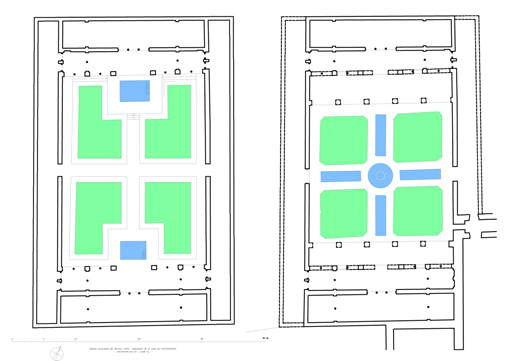living Domestic Spaces are arranged around a courtyard, Usually Gardener, Which is the "dejennat", "pharadaisos" or Home paradise, where, the believer lives a heavenly paradise premonition. ;
Large halls in Medina Azahara Are Located In Some Cases, as Abd-Al-Rahman II Hall, in an artificial terrace, built on strong holding a high garden walls with views to lower gardens and general landscape, trying to evoke the Babylon Hanging Gardens. West Hall palace stands on a paradise placed at its feet which is crossed y two cruciforms roads with pools or pavilions in its intersection. This is cross garden model, from Iranian origin like the garden planted by Cyrus the Younger himself, the great Persian warrior and prince as described by Xenophon. This garden was discovered by Deutsehe Archaeologisque Institut and is the oldest crossed garden known.
Palatine town of Medina Azahara (936-976) . General plan showing gardens.
Palatine town of Medina Azahara (936-976) . Plan of Eastern Garden.
Palatine town of Medina Azahara (936-976) . Longitudinal Section of Eastern Garden.
Palatine town of Medina Azahara (936-976) . Transverse Section of Eastern Garden.
Palatine town of Medina Azahara (936-976) . Aerial view of Eastern Garden.
This garden type arrived later to Islam, and we first find it in Ruzafa Palace in Syria, built during the reign of Hisham I, last Umayyad caliph. Abbasids built similar courtyards in Balkuwara palaces in Samarra. Abd al-Rahman I, Hisham I grandson, copied Ruzafa palace and garden near Córdoba. Turruñuelo, a framhouse close to Medina Azahara identifiable by photogrammetric was the model for later Hispanic crossed gardens.


General scheme of Sardis Gardens (Turkey, 6th c. B. C.)
Scheme of Hixem I's Cross Garden in Rezafa, Siria (7th c.)
Rafael Manzano excavated and made a garden anastylosis in Medina Azahara, known as Prince or Alberquilla Garden, which is the most perfect model of later andalusian houses. This courtyard, slightly rectangular, has two lateral walls in its longer sides. There are two pavilions in its two smaller sides, located at West and East. These pavilions consist on a long hall with lateral alcoves, some fictional, and preceded by a porch, enclosed by a gate with a triple horseshoe arches between two columns.
 Palatine town of Medina Azahara (936-976) . Alberquilla Court.
Palatine town of Medina Azahara (936-976) . Alberquilla Court. 





























0 comments:
Post a Comment